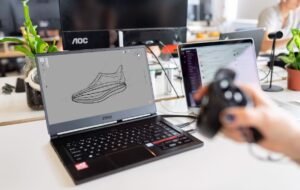Is Artificial Intelligence a Robot?
Artificial Intelligence (AI) and robots are terms often used interchangeably, leading to confusion regarding their relationship. While the two concepts overlap in some areas, they have distinct differences. It is crucial to understand the distinctions to fully comprehend the capabilities and limitations of AI and robots.
Key Takeaways
- Artificial Intelligence is the simulation of human intelligence in machines.
- A robot is a physical entity that can be programmed to perform tasks autonomously.
- AI can exist without a physical presence, while robots require physical form to function.
Artificial Intelligence vs. Robots
Artificial Intelligence refers to the simulation of human intelligence in machines that are programmed to think and learn like humans. It encompasses various technologies, including machine learning, natural language processing, and computer vision, enabling AI systems to process and analyze large amounts of data to make informed decisions. **AI can understand, reason, and learn from data to mimic human cognitive abilities**.
A robot, on the other hand, is a physical entity designed to interact with its environment and perform tasks autonomously or under remote control. **Robots are programmable machines capable of carrying out specific functions in a physical world**. While some robots incorporate AI technologies to enhance their capabilities, not all robots possess AI. Many robots operate based on pre-programmed instructions without adaptive learning abilities.
The Relationship Between AI and Robots
While AI and robots are distinct concepts, they intersect in certain areas. AI can be used to enhance robots’ capabilities by enabling them to process data, recognize speech, or interpret visual information. **By integrating AI, robots can become more intelligent, adaptable, and better at interacting with humans**.
However, it’s important to note that not all AI systems are embodied as robots. **AI can exist purely as software systems, such as virtual assistants or recommendation engines, without any physical presence**. These AI systems can be accessed through smartphones, computers, or other devices that connect to the internet.
The Limitations and Advantages of AI and Robots
Table 1: Limitations of AI and Robots
| AI | Robots |
|---|---|
| Requires large amounts of high-quality data for training. | Can perform physical tasks and operate in complex environments. |
| May lack common sense reasoning abilities. | Can interact with physical objects and manipulate them. |
| May have ethical implications in decision-making. | Can perform repetitive tasks with high precision and accuracy. |
As AI relies heavily on data, the quality and quantity of available data significantly impact its learning and decision-making capabilities. **Additionally, AI may lack common sense reasoning abilities that humans possess naturally**.
Robots, on the other hand, excel in performing physical tasks and operating in complex environments. **They can interact with physical objects, manipulate them, and carry out repetitive tasks with high precision and accuracy**. However, some ethical considerations arise when robots are involved in decision-making processes as they may strictly follow programmed rules without considering broader implications.
Future Implications
Table 2: Applications of AI and Robots
| AI | Robots |
|---|---|
| Virtual assistants | Manufacturing automation |
| Image recognition | Agricultural robots |
| Financial fraud detection | Medical surgery robots |
The future implications of AI and robots are vast. AI systems have the potential to revolutionize industries such as healthcare, finance, and transportation through advanced data analysis and decision-making capabilities. **Robots, with enhanced AI integration, can bring significant advancements in manufacturing automation, agricultural practices, and even perform complex medical procedures**.
Table 3: Collaboration between AI and Robots
| Benefits | Challenges |
|---|---|
| Improved efficiency and productivity | Job displacement concerns |
| Enhanced human-robot interaction | Security and privacy risks |
| Advancements in complex problem-solving | Ethical implications of autonomous decision-making |
The collaboration between AI and robots presents both benefits and challenges. **Improved efficiency and productivity can be achieved through the integration of AI in robots, leading to advancements in complex problem-solving and enhanced human-robot interaction**. However, concerns regarding job displacement, security, privacy risks, and ethical implications of autonomous decision-making need to be addressed for responsible deployment and usage of AI-driven robots.
The intricate relationship between AI and robots offers great potential for innovation in various domains. While AI represents the intelligence, reasoning, and learning capabilities, robots embody the physical presence and ability to interact with the environment. With continuous advancements in both fields, the future holds exciting possibilities for the integration and impact of AI-driven robots.

Common Misconceptions
Artificial Intelligence and Robots
One of the most common misconceptions about artificial intelligence is that it always refers to a physical robot. While robots can indeed be powered by artificial intelligence, AI itself is not limited to robots. AI refers to the ability of machines or computer systems to simulate human intelligence and perform tasks that would normally require human intelligence. Here are three points to consider:
- AI is present in various forms, such as virtual assistants like Siri and Alexa, recommendation algorithms used by streaming platforms, and even in self-driving cars.
- Artificial intelligence can exist purely as software or algorithms that operate on data without any physical presence.
- Not all robots are artificially intelligent. Many robots are programmed to perform specific tasks and do not possess AI capabilities.
Unthinking Machines
Another common misconception is that AI is capable of true consciousness and independent thought. In reality, AI systems do not have consciousness or emotions. They are designed to process data, learn from it, and make decisions or perform tasks based on that data. Here are three points to consider:
- AI systems are dependent on the algorithms and data they are trained on and do not possess the ability to think critically or make decisions beyond their programming.
- AI can mimic human behavior and perform tasks that require intelligence, but this does not mean they have a subjective experience or self-awareness.
- True intelligence involves more than just data processing – it encompasses emotions, creativity, and abstract thinking, which AI systems currently lack.
Replacing Human Workers
There is a widespread fear that AI will replace human workers in various industries, leading to massive unemployment. While it’s true that AI can automate certain tasks and make some roles obsolete, it is not likely to completely replace human workers in most fields. Here are three points to consider:
- AI is more effective at performing repetitive, rule-based tasks that are mundane or time-consuming for humans.
- AI systems are still far from being able to replace human intelligence in complex problem-solving, creativity, and social interactions, which are crucial in many professions.
- AI is more likely to augment human capabilities, allowing workers to focus on higher-level tasks that require uniquely human skills like empathy, critical thinking, and adaptability.
Evolving and Learning Machines
Many people believe that once an AI system is trained, it will remain static and unchanging. However, AI is a field that is constantly evolving and improving. Here are three points to consider:
- AI systems can continue to learn and adapt over time through processes like machine learning, deep learning, and reinforcement learning.
- As new data becomes available, AI models can be retrained to improve their performance and accuracy.
- Ongoing research and development in the field of AI contribute to advancements, making AI systems more efficient, capable, and reliable.

Is Artificial Intelligence a Robot?
Artificial intelligence has become a buzzword in the world of technology and innovation. However, there is often confusion regarding the distinction between artificial intelligence and robots. While robots can be powered by artificial intelligence, the two terms are not interchangeable. This article aims to clarify this confusion by exploring some interesting data and elements related to artificial intelligence and robots.
The Origins of Artificial Intelligence and Robots
Humans have long been fascinated by the concept of creating intelligent beings and machines that can perform tasks with human-like capabilities. The development of artificial intelligence and robots has its roots in centuries of exploration and experimentation. Let’s take a look at some pioneering moments:
| Year | Event |
|---|---|
| 1770 | The mechanical chess-playing machine, known as “The Turk,” debuts and captivates audiences with its seemingly intelligent moves. |
| 1950 | Computer scientist Alan Turing introduces the concept of the Turing Test, a benchmark for determining a machine’s ability to exhibit intelligent behavior. |
| 1961 | Unimate, the first industrial robot, is installed on the General Motors assembly line, marking the beginning of robotic automation. |
| 1997 | IBM’s Deep Blue defeats world chess champion Garry Kasparov, demonstrating the power of artificial intelligence in strategy and decision-making. |
Differences between Artificial Intelligence and Robots
While artificial intelligence and robots share a close relationship, it is essential to distinguish between the two. Take a look at the following characteristics to better understand their differences:
| Characteristics | Artificial Intelligence | Robots |
|---|---|---|
| Ability to Think | Capable of simulating human cognitive processes, such as learning, problem-solving, and decision-making. | A physical machine, typically with mechanical components, capable of executing physical actions. |
| Applications | Used across various domains, including healthcare, finance, transportation, and gaming, to enhance efficiency and drive innovation. | Utilized for tasks that can benefit from automation, such as assembly lines, surgical procedures, and exploration in hazardous environments. |
| Form | Software-based technology that exists in computer systems, enabling machines to perform intelligent tasks. | Physical structures that encompass mechanical, electrical, and computational components. |
Artificial Intelligence and Robots in Pop Culture
The influence of artificial intelligence and robots can be seen throughout popular culture in movies, books, and other media forms. Here are some fascinating examples:
| Medium | Example |
|---|---|
| Film | “Blade Runner” (1982) – Depicts a dystopian future where advanced humanoid robots called “replicants” challenge the boundaries of humanity. |
| Literature | “I, Robot” (1950) – A collection of science fiction short stories by Isaac Asimov that explores the relationships between robots and humans. |
| Music | “Technologic” by Daft Punk – This song highlights the increasing integration of technology and AI in our daily lives. |
The Future of Artificial Intelligence and Robotics
The rapid advancements in artificial intelligence and robotics hold immense potential for shaping the future. Let’s explore some noteworthy predictions:
| Predictions | Description |
|---|---|
| Robotic Assistants | Robots will become common in households, aiding with household chores, healthcare monitoring, and companionship. |
| Autonomous Vehicles | Self-driving cars will revolutionize transportation, reducing accidents, congestion, and offering more efficient mobility solutions. |
| AI-Driven Healthcare | Artificial intelligence will enhance medical diagnosis, drug development, and personalized treatment plans. |
The Ethical Dilemmas of Artificial Intelligence and Robots
As artificial intelligence and robots continue to evolve, ethical questions arise. Here are some thought-provoking dilemmas:
| Ethical Dilemma | Description |
|---|---|
| Job Displacement | The potential automation of jobs raises concerns about unemployment and the need for retraining and reskilling the workforce. |
| Privacy and Surveillance | The collection and utilization of vast amounts of data by AI systems raise concerns about privacy invasions and surveillance. |
| Accountability and Responsibility | When AI makes autonomous decisions, the question of who should be accountable and responsible for any negative consequences arises. |
The Collaborative Future: Humans and AI
Contrary to popular fears of AI overpowering humanity, the future is likely to be characterized by a collaborative relationship between humans and AI. By leveraging the strengths of both, we can achieve remarkable advancements and create a more efficient and inclusive society.
Conclusion
As we delve into the world of artificial intelligence and robots, it becomes clear that while artificial intelligence powers robots, it is not synonymous with them. Artificial intelligence encompasses the ability to simulate human cognitive processes, while robots are physical machines that can execute tasks. From historical milestones to popular culture references, the influence of AI and robots is pervasive. The future holds exciting possibilities, but also ethical considerations that require thoughtful discussions. As we navigate this evolving landscape, embracing a collaborative future between humans and AI will pave the way for remarkable progress.
Is Artificial Intelligence a Robot?
FAQs
Is artificial intelligence the same as a robot?
Do all robots have artificial intelligence?
Can artificial intelligence exist without a physical body?
Can artificial intelligence be integrated into non-robotic devices?
Do all AI systems exhibit human-level intelligence?
Can robots with AI learn and adapt over time?
Can robots with AI understand human emotions?
Are AI systems vulnerable to biases?
What is the impact of AI on job opportunities?
Are there ethical considerations associated with AI and robots?




